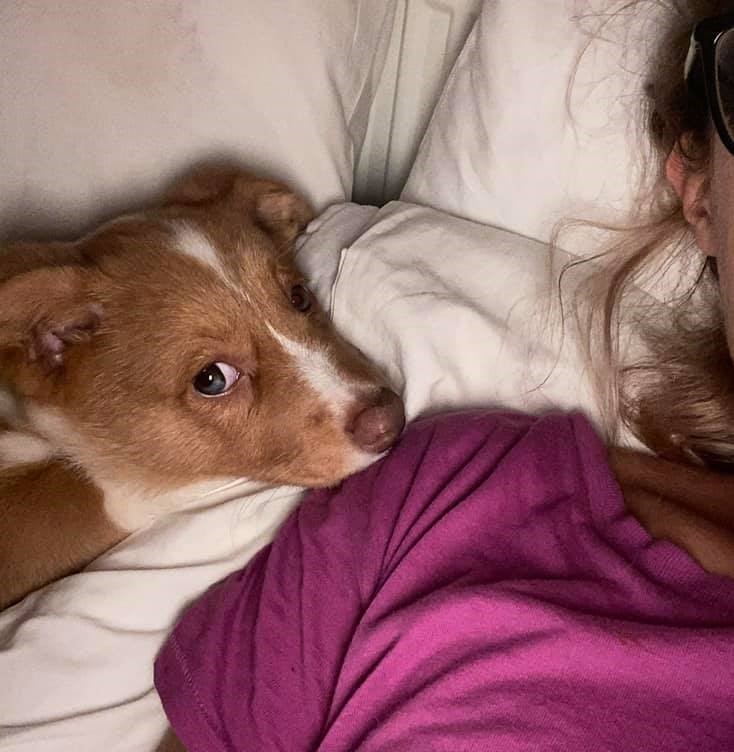Why what we learnt from children also applies to puppies, by Emma Judson

There has since at least 1913, been a school of thought that suggests leaving tiny babies to ‘cry it out’, ie, cry until they give up crying, with the parent no longer responding to cries for attention, comfort or contact, is beneficial or indeed, necessary in raising children.
Somewhere along the line this also became the advice applied to puppies, with the warnings that if you respond to a pup’s cries for attention, you would as with the child-oriented version of this advice, create a needy individual who was insecure and lacking in confidence.
We now know the opposite is true. Unfortunately, from a dog perspective very few studies are done on dogs, simply because there isn’t the money in it to carry them out.
So we are left to extrapolate from studies done on children, but that’s actually OK, because a dog’s brain is comparable to the brain of a child under two years of age. They have similar needs for comfort, warmth, food, physical contact, social support. They have similar difficulties in communicating orally, in lacking impulse control and lacking fine motor skills.
So here’s the grim truth.
Young mammals left to ‘cry it out’ do not ‘self soothe’. In fact what they learn (Bowlby J. 1960s) is that after going through a cycle of protestation, then despair, they reach a third phase of detachment. In effect they give up trying to get a response, get comfort or contact and become apathetic. Their distress is still present; they have simply learnt it will not be alleviated as a result of their behaviour. They have shut down.
While the theory ran that if you provide attention constantly so that the young mammal in question does not need to cry, or you respond promptly to their cries, they will cry more, seek attention more, in fact the opposite is true.
A study in 1986 demonstrated that the more the mother holds and carries her baby, the less that baby will cry and fuss. Other studies (cross-cultural but still human, not dog) showed that those parents who responded quicker to crying babies also have babies who cry far less often!

Going back to puppies, we have taken them from their mothers, their littermates and their familiar environment.
If we compare our domestic dog to feral and wild dog populations, we see that our domestic puppies experience this separation from their primary care giver and litter mates at (on average) between six and 12 weeks of age.
Their wild/feral counter parts are in the constant company of litter mates and the near constant company of their parent until weaning. Beyond weaning, they are still in the constant company of littermates, parent and other relatives unless they choose to be alone. This is unlikely to happen before adolescence and the hormonal changes that are related to adolescence.

It is true that domestic dogs and wild or feral canids are not the same, but the difference is that domestic dogs actively want to be with humans rather than with other canids. That being so, they are in no way equipped to be isolated and alone, any more than the feral or wild dogs would be.
So what are the risks of subjecting a puppy to isolation from a social group or new primary caregiver, and ignoring cries for company, comfort or contact?
- The increased cortisol levels can actually damage or kill off neurons and the neuronal interconnections. This can affect how well your dog copes with stress, anxiety and fear in future, predisposing them to be more reactive and fearful
- Stress hormones go up faster than they come back down. So that stressful experience is affecting the dog for much longer than you might think. Possibly days
- Repeatedly increasing stress hormones will inhibit learning, affect sleep, affect bonding and attachment
- Repeated stressful experiences that the subject cannot escape from leads to PTSD in humans. We have no evidence to suggest that this does not also happen in dogs. Given the similarities between the human and canine brain, it is reasonable to assume dogs can also experience something similar to PTSD
The short version of all this is: there is no benefit to leaving a dog to cry it out. Separation anxiety is normal for puppies, they need to be with someone most of the time!
Separation anxiety as an abnormal behavioural issue comes about because of an insecure dog, who has not been taught how to cope by themselves, not as a result of creating a secure, confident dog who is given what they need as a puppy.
